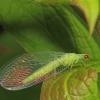When a land steward asks for recommendations for increasing the number of pollinators in their landscape, many times the initial request is to start a pollinator meadow from seed. Their vision is usually a diverse meadow with an emphasis on native flowers and grasses. These meadows not only provide nectar and pollen as food for our native pollinators and beneficial insects, but also provide nesting and overwintering habitat in the stems, bunch grasses, and undisturbed ground. We love successful wildflower meadows started from scratch because they can have a high diversity of native species, can be showy with continuous blooms, and promote beauty in natural areas, backyards, and on farms—and even support agritourism.
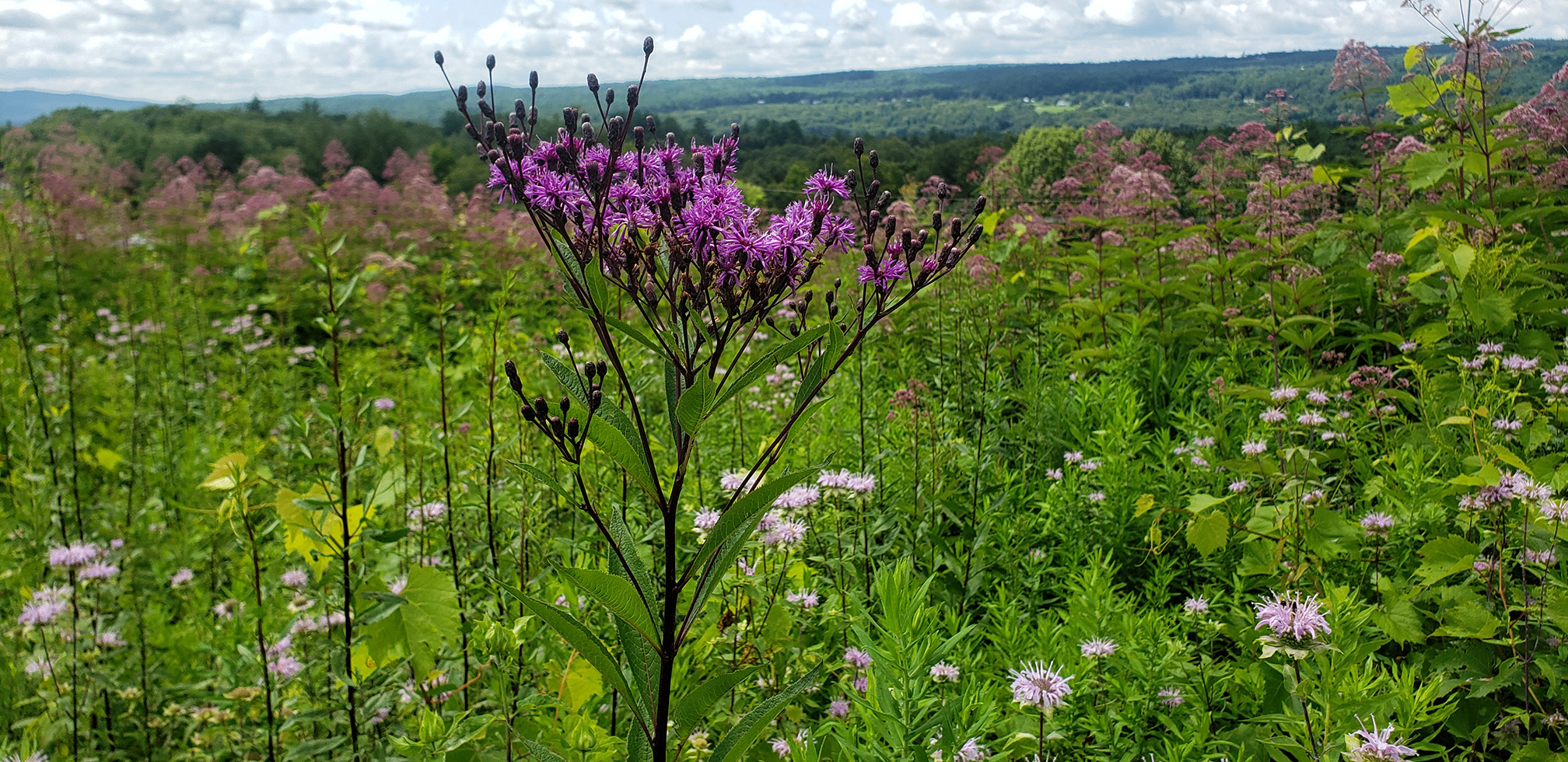
An established meadow that was started from scratch, using aggressive site preparation prior to direct seeding of a diverse native and naturalized wildflower seed mix. The tall plant in the foreground is ironweed, around it is bergamot, and in the background is joe pye weed. This photo was taken at Alyson’s Orchard in New Hampshire, during an NRCS training on creating habitat for pollinators led by Xerces Conservationist and NRCS Partner Biologist Alina Harris and NH-NRCS State Biologist, Kelly Boland. (Photo: Xerces Society / Alina Harris.)
When starting from scratch, however, it’s important to note that during the first couple of years of establishment, it’s not all flowers and butterflies. To learn about some of the detailed methods and timelines used, download a copy of the Xerces publication Organic Site Preparation for Wildflower Establishment. For New England specific site preparation methods including black tarp, visit Native Pollinator Biodiversity: The Contributions of Native Pollinator Meadows.
In towns and cities, a growing number of gardeners are converting mowed lawn to pollinator habitat. On farms, it is common to begin with old hay lands that are mowed less frequently. These sites are dominated by non-native grasses and tend to have thick, mat-forming root systems with lots of thatch and residue on the surface. Aggressive site preparation is needed before sowing tiny native seeds into the prepared soil surface. Some of the native perennials take up to three years before flowering. Funding is also a consideration. It isn’t exactly cheap to buy high-quality, locally adapted native seed, as well as the other materials needed to prepare the site. It’s hard work, but when all these steps are taken, starting from scratch can yield glorious results for years to come. It has made many pollinators, larger wildlife, and humans overjoyed across the United States!
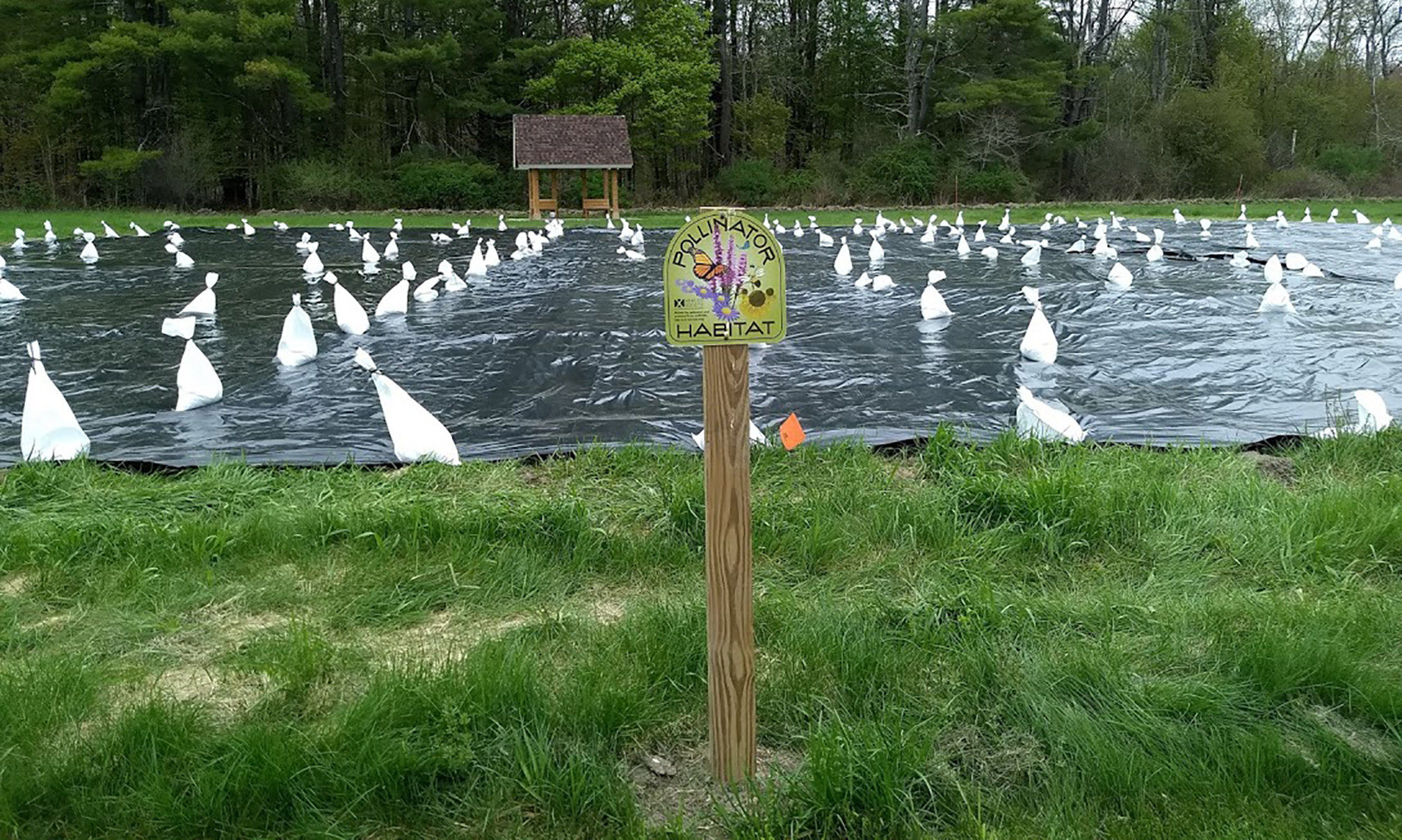
An organic and no-till method of site preparation using black tarp, weighted down with sand bags. This is in preparation to direct seed from scratch using a diverse native wildflower mix. The project is at Hillside Village in Keene, NH, which received a Conservation Opportunity Fund through Cheshire County Conservation District. The Hillside Village is also the recipient of a Northeast monarch habitat kit from the Xerces Society. (Photo: Marty Post, Hillside Village.)
Many times though, landowners don’t have necessary funding or labor hours to put towards from-scratch pollinator habitat projects. They are interested in helping pollinators, but might have a larger landscape to manage and are looking for more casual methods that are affordable over a larger scale. If there is already the beginning of decent pollinator habitat in a system, a suitable option is to change the mowing regime—which may be as simple as to not mow it during the summer months and wait to mow after a frost or two in the autumn. Over time, existing flowering plants that are already present in the soil will begin to increase.
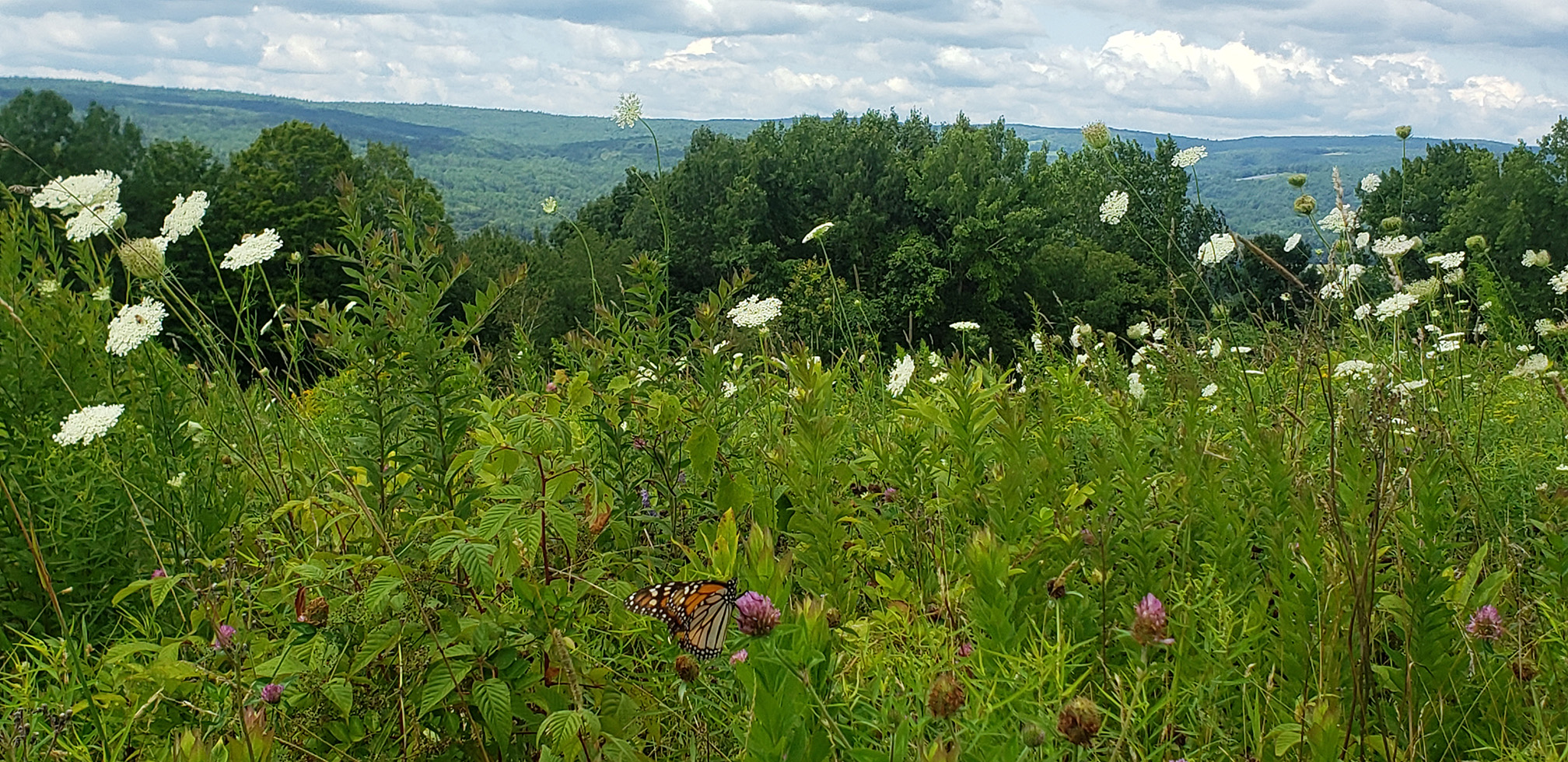
An orchard edge that was left unmowed for 2021 with blooming forbs. The flowers included non-native red clover and Queen Anne’s lace as well as self-sown native blackberries, common milkweed, spiraea, pale-spiked lobelia, and showy tick-trefoil. An adult monarch is nectaring on non-native red clover. The photo was taken at Alyson’s Orchard, New Hampshire, during an NRCS training on creating habitat for pollinators led by Xerces Conservationist and NRCS Partner Biologist Alina Harris and NH-NRCS State Biologist, Kelly Boland. (Photo: Xerces Society / Alina Harris.)
Habitat areas managed by delayed mowing may not exhibit the same diversity of native plants as a from-scratch meadow. For example, there may be a prevalence of introduced species such as Queen Anne’s lace and red clover in areas previously managed by humans. At the same time, native pollinators such as bumble bees and monarch butterflies forage on non-native red clover flowers. Delayed-mowing meadows may result in less flower diversity, but can still provide meaningful pollinator value in areas with just a simple change of the mowing regime. Ideally, sites would mow about one-third of the acreage per year on a rotational basis: Since native invertebrates overwinter in the stems and bunch grasses, two-thirds of the area may be left undisturbed while one-third is mowed to reduce woody encroachments and maintain open pollinator habitat.
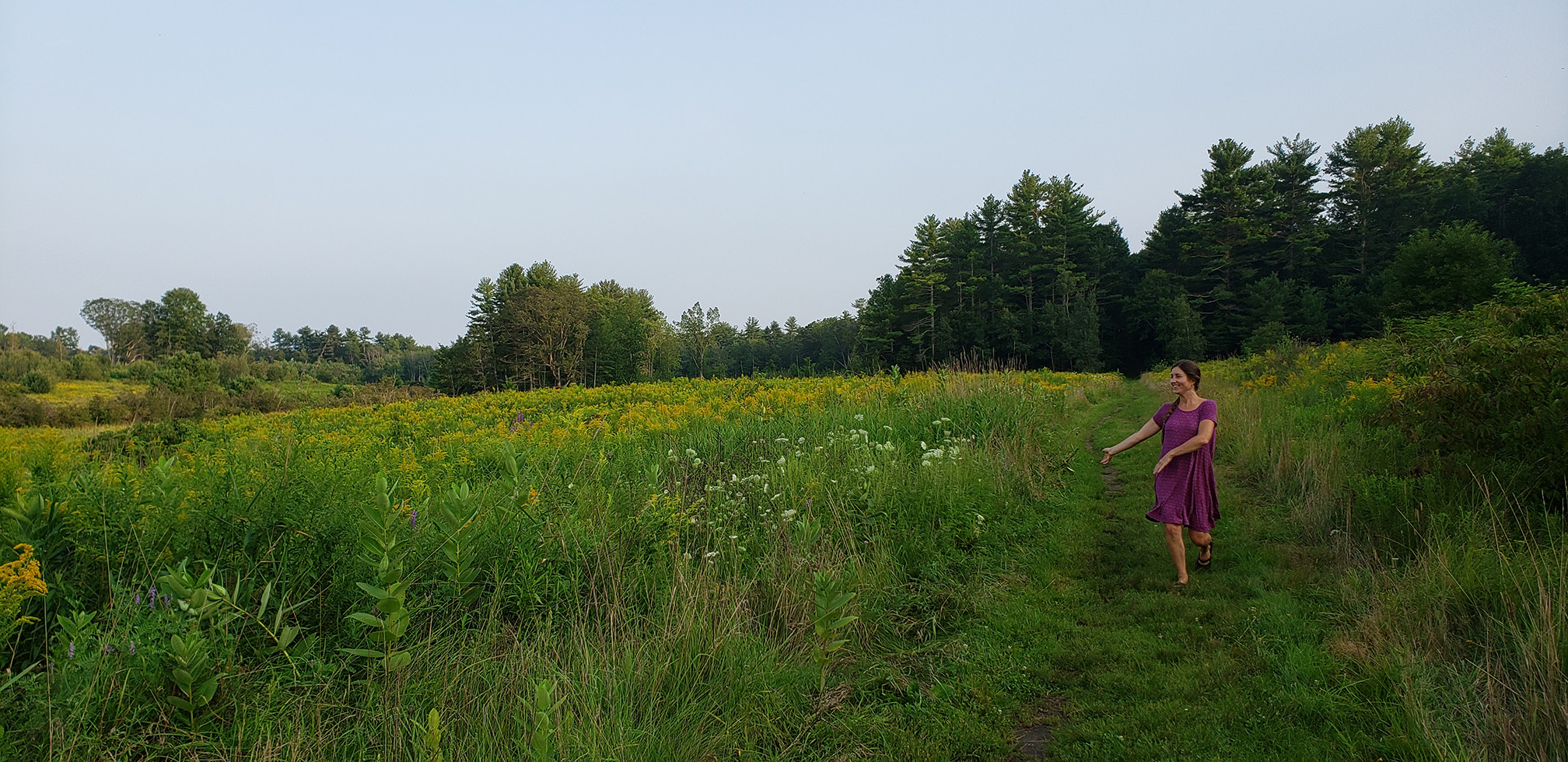
Nina Harris enjoying a public flowering meadow at Spruce Hole Conservation Area, Durham, NH. This area is managed with a rotational delayed-mowing regime to maintain open characteristics for pollinators and ground-nesting birds. In mid- to late-summer the abundance of goldenrod and common milkweed is abuzz with bees and flitting monarchs. (Photo: Alina Harris.)
For more information on delayed mowing regimes, visit page 18 (“Adjusting Mowing Practices to Benefit Pollinators”) of the Xerces Society publication Roadside Best Management Practices that Benefit Pollinators.
Your local USDA Natural Resources Conservation Service field office can also help if you are interested in establishing new pollinator habitat or changing your mowing regime to increase flowering diversity on private land. Reach out to your local NRCS field office to start the conversation and potentially receive funding towards your conservation efforts.
For gardeners who want to reduce time spent mowing their lawn and gradually increase flowering species diversity, check out Bee Friendlier with Your Lawncare on the Xerces blog.
Further Reading
Download a copy of Organic Site Preparation for Wildflower Establishment
Read more about Maintaining Diverse Stands of Wildflowers Planted for Pollinators
Find plant lists, habitat management guidance, and much more in the Pollinator Conservation Resource Center
Learn more about the Xerces Society’s Pollinator Conservation Program.
Discover how you can help Bring Back the Pollinators.



